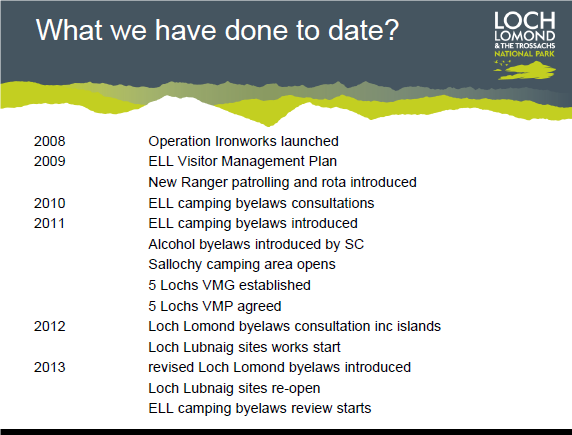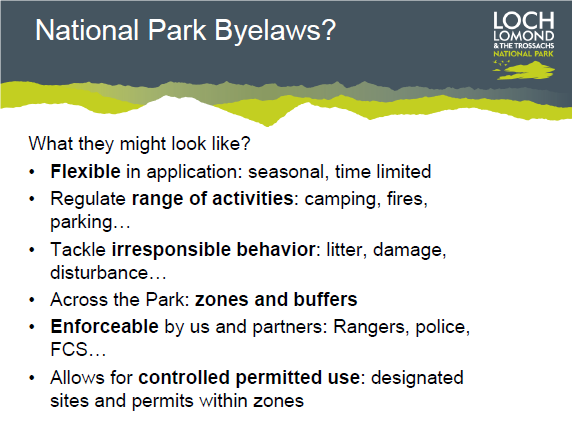
I have been puzzling about the development of the camping byelaws by the Loch Lomond and Trossachs National Park now for some time. Back in 2011 when the east Loch Lomond camping byelaws were put into place, the then LLTNPA Chief Executive Fiona Logan made a number of statements (these are taken from BBC News Bulletin 10th March 2011:
National park chief executive Fiona Logan said she did not believe there were any other areas of the park where similar bans would be “appropriate”
She told BBC Scotland that the by-laws were not permanent and could be revoked if the park was confident the problems had been successfully tackled.
“We would like not to have these laws in three years,” she said.
Yet, less than two years later the LLTNP submission to the Land Reform Review Group advocated that the right to camp within a certain distance of a public road should be removed completely from access rights and that sanctions be introduced, in the form of Fixed Penalty Notices, for breaches of the Scottish Outdoor Access Code. This would have completely changed the Land Reform Act. The LLTNPA proposals were rejected by the Land Reform Review Group which had been charged with reviewing how our access legislation was working in their Interim report of May 2013 and the LLTNPA proposals, along with other access matters, were referred to the National Access Forum for further consideration:
Just four months after being told by the LRRG that there was no need for the changes in our access laws the LLNPA Board held its first secret meeting to consider using its powers as a National Park Authority to change the law.

There is no evidence, as far as I am aware, that the National Access Forum ever discussed the LLTNPA submission on camping or that the LLTNPA tried to engage the National Access Forum about visitor management in the National Park. If this was not a conspiracy, I am not sure what would be. No wonder the LLTNPA developed its byelaw proposals in secret because if they had done so openly they would have been seen to flout the recommendations of the LRRG.
What the Information Response I received last week EIR 2017-004 Response LRRG and EIR 2017-004 LRRG Appendix A shows is two things:
- First, the submission which purportedly came from the Loch Lomond National Park Authority to the Land Reform Group was never considered by the Board (this conclusion follows from the Park’s declaration that it holds no information on meetings or communications between Board Members to discuss this matter).
- Second, that Linda McKay, the Convener of the Board headed the delegation which met with the LRRG on 15th February 2013 to discuss the LLTNPA submission. This also included Grant Moir, now Chief Executive of the Cairngorms National Park, Gordon Watson (current Chief Executive LLTNPA) and Bridget Jones.
What this tells us is that Linda McKay was personally leading the case to change our access laws despite not having discussed or agreed this with her Board. Just how far individual members of staff were willing participants in this is unclear but Grant Moir had previously said publicly he did not support any further extension of the byelaws. The submission to the LRRG did say though that this might be reconsidered AFTER the review of the East Loch Lomond byelaws. That review only took place in March 2014 so what’s quite clear is, that having told the LRRG there were no immediate plans to extend byelaws, someone in the Park then authorised staff to spend time working up proposals to do just that for the Board in September 2013. That person, it appears, was Linda McKay, the Board Convener.
All the evidence therefore now points to Linda McKay, a Scottish Government appointee to the Board who is also a non-executive director of the civil service, as being the driving force behind the camping byelaws. It appears therefore that she is also responsible for the secretive process that has led to them being approved first by the LLTNPA Board and then approved by the Minister for the Environment.
The timeline is as follows:
- 2011 introduction east Loch Lomond camping byelaws
- October 2012 – January 2014 Call for evidence LRRG – LLTNPA submit response
- 15th February 2013 LLTNPA meeting LRRG led by Linda McKay
- 20th May 2013 Interim Report form LRRG referring LLTNPA and other submissions to National Access Forum
- 9th September 2013 first secret “Board Briefing” session to discuss camping byelaws
- 28th October 2013 most of secret “Board Briefing” session taken up with camping byelaws
- December 2013 Board Meeting – Visitor Management paper (first time visitor management plans raised publicly, camping just one of number of issues)
- 17th March 2014 Board Meeting. Review of East Loch Lomond byelaws signed off and sent to Scottish Government
- 23rd May 2014 Final report LRRG – proposes no changes to access legislation (just as the LLTNPA was undertaking intensive drive community organisations in the LLTNPA to get them on side for the byelaws)
- October 2014 launch Your Park consultation proposing byelaws